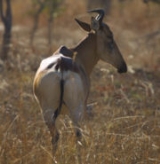
Lichtenstein's Hartebeest
Encyclopedia
Lichtenstein's Hartebeest (Alcelaphus lichtensteinii) is a savanna
h and floodplain
dwelling antelope
found in southern Central Africa
. By some this species is classified as Sigmoceros lichtensteinii.
Lichtenstein's Hartebeest typically stand about 1.25 m (4 ft) at the shoulder and have a mass of around 150 kg (330 lb). Lichtenstein's Hartebeest are a red brown colour, which is lighter on the underbelly. The horns found on both sexes appear from the side to be shaped like the letter 'S
' and appear from the front to be shaped like the letter 'O
' with its upper portions missing. The horns are slightly ridged and reach over 0.5 m in length.
Lichtenstein's Hartebeest live on savanna
s and floodplain
s where they eat grass
. They are diurnal
(active in the day). They gather in herds of five to fifteen females and calves with a single male who leads them. The male stands sentry duty on termite
mounds and the like. Males hold large territories, which they mark by digging up dirt with their horns around the borders. Lichtenstein's Hartebeest have good eyesight but a poor sense of smell. Their main sounds are a bellow and a sneeze-snort sound.
It derives its name from zoologist Martin Lichtenstein
.
Savanna
A savanna, or savannah, is a grassland ecosystem characterized by the trees being sufficiently small or widely spaced so that the canopy does not close. The open canopy allows sufficient light to reach the ground to support an unbroken herbaceous layer consisting primarily of C4 grasses.Some...
h and floodplain
Floodplain
A floodplain, or flood plain, is a flat or nearly flat land adjacent a stream or river that stretches from the banks of its channel to the base of the enclosing valley walls and experiences flooding during periods of high discharge...
dwelling antelope
Antelope
Antelope is a term referring to many even-toed ungulate species indigenous to various regions in Africa and Eurasia. Antelopes comprise a miscellaneous group within the family Bovidae, encompassing those old-world species that are neither cattle, sheep, buffalo, bison, nor goats...
found in southern Central Africa
Central Africa
Central Africa is a core region of the African continent which includes Burundi, the Central African Republic, Chad, the Democratic Republic of the Congo, and Rwanda....
. By some this species is classified as Sigmoceros lichtensteinii.
Lichtenstein's Hartebeest typically stand about 1.25 m (4 ft) at the shoulder and have a mass of around 150 kg (330 lb). Lichtenstein's Hartebeest are a red brown colour, which is lighter on the underbelly. The horns found on both sexes appear from the side to be shaped like the letter 'S
S
S is the nineteenth letter in the ISO basic Latin alphabet.-History: Semitic Šîn represented a voiceless postalveolar fricative . Greek did not have this sound, so the Greek sigma came to represent...
' and appear from the front to be shaped like the letter 'O
O
O is the fifteenth letter and a vowel in the basic modern Latin alphabet.The letter was derived from the Semitic `Ayin , which represented a consonant, probably , the sound represented by the Arabic letter ع called `Ayn. This Semitic letter in its original form seems to have been inspired by a...
' with its upper portions missing. The horns are slightly ridged and reach over 0.5 m in length.
Lichtenstein's Hartebeest live on savanna
Savanna
A savanna, or savannah, is a grassland ecosystem characterized by the trees being sufficiently small or widely spaced so that the canopy does not close. The open canopy allows sufficient light to reach the ground to support an unbroken herbaceous layer consisting primarily of C4 grasses.Some...
s and floodplain
Floodplain
A floodplain, or flood plain, is a flat or nearly flat land adjacent a stream or river that stretches from the banks of its channel to the base of the enclosing valley walls and experiences flooding during periods of high discharge...
s where they eat grass
Grass
Grasses, or more technically graminoids, are monocotyledonous, usually herbaceous plants with narrow leaves growing from the base. They include the "true grasses", of the Poaceae family, as well as the sedges and the rushes . The true grasses include cereals, bamboo and the grasses of lawns ...
. They are diurnal
Diurnal animal
Diurnality is a plant or animal behavior characterized by activity during the day and sleeping at night.-In animals:Animals that are not diurnal might be nocturnal or crepuscular . Many animal species are diurnal, including many mammals, insects, reptiles and birds...
(active in the day). They gather in herds of five to fifteen females and calves with a single male who leads them. The male stands sentry duty on termite
Termite
Termites are a group of eusocial insects that, until recently, were classified at the taxonomic rank of order Isoptera , but are now accepted as the epifamily Termitoidae, of the cockroach order Blattodea...
mounds and the like. Males hold large territories, which they mark by digging up dirt with their horns around the borders. Lichtenstein's Hartebeest have good eyesight but a poor sense of smell. Their main sounds are a bellow and a sneeze-snort sound.
It derives its name from zoologist Martin Lichtenstein
Martin Lichtenstein
Martin Hinrich Carl Lichtenstein was a German physician, explorer, zoologist, and herpetologist.-Biography:...
.

